
This artwork imagines the ultimate front-row seat for GW250114, a powerful collision between two black holes observed in gravitational waves by the US National Science Foundation LIGO. It depicts the view from one of the black holes as it spirals toward its cosmic partner.
Yesterday's Astronomy Picture of the Day #APOD featured #GW250114! This artwork imagines the ultimate front-row seat as two black holes spiral together on their way toward producing the strongest gravitational-wave signal we've detected so far
apod.nasa.gov/apod/ap25092...
🎨A Simonnet 🔭🐚
25.09.2025 08:16 — 👍 81 🔁 17 💬 1 📌 0

A sheet cake decorated with "Happy 10 Birthday GW150914", confetti, balloons, a binary black hole, and the data from our first detection, as well as the OzGrav logo. It is edged with some creamy frosting.
Last Sunday was the 10th anniversary of our first #GravitationalWave detection!
Join us for a thread of celebratory cakes enjoyed by members of our collaboration
First, a cake from @ozgrav.bsky.social Looks like plenty to share?
🖼️: J Powell
🧵🎂 #GW10Years
19.09.2025 17:02 — 👍 34 🔁 5 💬 4 📌 2

A screenshot from LIGO Magazine article "A path to fossil-free supercomputing". The image shows the title of the article displayed over a photo of the LUMI data centre in Finland. The data centre is in a large building and is artistically lit in shades of blue.
Image credit: Fade Creative.
In the latest edition of #LIGOMagazine, Ivan Markin chats with Pekka Manninen from LUMI (@lumi-supercomputer.eu) about paths to fossil free computing & the LUMI experience of using 100% renewables.
Read all about it at (pdf, page 40): ligo.org/wp-content/u...
#ClimateChangeConversations
#GW10Years
22.09.2025 15:30 — 👍 1 🔁 0 💬 0 📌 0
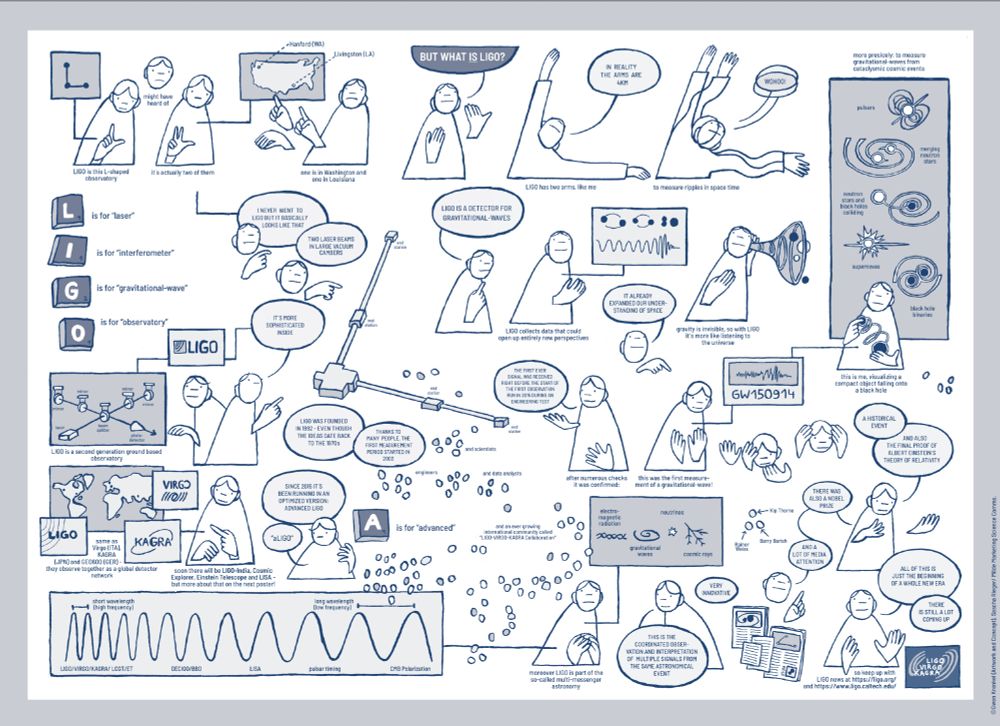
"What is LIGO?" poster. The poster features a range of line drawings in blue and white explaining LIGO and its science. In each scene the character explains an aspect of LIGO or gravitational-wave science. The poster includes information including: LIGO has 4km long arms; the location of the LIGO instruments in Hanford and Livingston; the first detection happened in 2015; the other gravitational wave detectors are Virgo in Italy, KAGRA in Japan, GEO600 in Germany.
And the other poster takes a look at @ligo.org @egovirgo.bsky.social KAGRA and their science.
By Gwendolyn Krenkel (Artwork and Concept), Sascha Rieger/ Milde Marketing Science Comms.
Full resolution version at: dcc.ligo.org/G2501956/pub...
#GW10Years
18.09.2025 14:54 — 👍 8 🔁 3 💬 0 📌 0

A poster in purples, pinks and blues showing a timeline of gravitational wave science. The timeline starts in the 1910s with the proposal of the existence of gravitational waves and goes up to the present day when we celebrate 10 years of gravitational wave observations as well as looking to future wit new facilities being planned and built. Throughout the timeline, there are illustrations showing black holes, neutron stars, gravitational waves and interferometers.
We are thrilled to feature two posters in the latest #LIGOMagazine!
One poster explores the evolution of #GravitationalWave science.
By Yi Shuen Christine Lee / Carl Knox / @ozgrav.bsky.social
Full resolution version at: dcc.ligo.org/G2501957/pub...
#GW10Years @ligo.org @egovirgo.bsky.social
18.09.2025 14:45 — 👍 1 🔁 0 💬 1 📌 0
Friends, did you know that @ligo.org and @ligomagazine.bsky.social were on Bluesky? If you want to keep up to date with the gravitational wave world go follow them!
🧪🔭
18.09.2025 03:05 — 👍 39 🔁 10 💬 2 📌 0
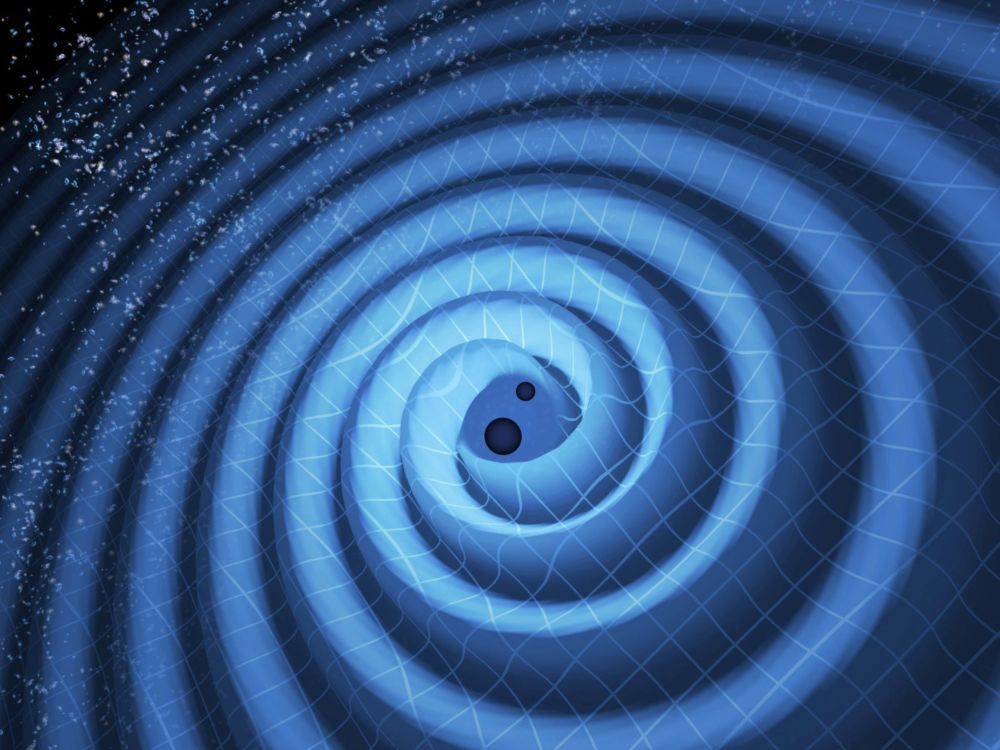
A decade of detecting gravitational waves
To boldly LIGO...
A decade of detecting gravitational waves: The Naked Scientists podcast catch up on the current status of gravitational-wave astronomy and future plans, including an interview with Prof. Gaby Gonzalez
www.thenakedscientists.com/podcasts/nak...
#GW10Years 🔭🧪⚛️
17.09.2025 13:59 — 👍 33 🔁 4 💬 0 📌 1

Louis Dartez receiving his LIGO Calibration Wizard hat at the September 2025 LIGO-Virgo-KAGRA meeting from Jess McIver. The hat is a traditional pointy blue hat, but is covered with images of lasers.
During the recent LIGO @egovirgo.bsky.social KAGRA meeting, the 2024 winner of the LIGO Laboratory Award for Excellence in Detector Characterization and Calibration, Louis Dartez, received his honorary Calibration Wizard hat.
Congratulations to Dr. Dartez!
www.ligo.caltech.edu/page/award-e...
16.09.2025 14:16 — 👍 9 🔁 2 💬 0 📌 0
Exciting to get a first look at the #LISA spacecraft!
In the latest #LIGOMagazine, Oliver Jennrich & Nora Lützgendorf told us all about the selection of the industrial prime contractor.
Read all about it on page 34 (pdf): ligo.org/wp-content/u...
@lisacommunity.bsky.social #GW10Years
16.09.2025 16:04 — 👍 4 🔁 1 💬 0 📌 0

A digital drawing with text that says "happy birthday GW150914", a spacetime cake with a 10 and two black holes on it, and the GW150914 waveforms around it all
Happy birthday GW150914!
When you were detected I was still an undergrad looking to get into GWs for her PhD (it's important to my internal story of myself that I wanted to do this *before* the detection)
It's hard to believe how far we've come since then.
🐡🧪🔭
#GW10Years
15.09.2025 00:48 — 👍 36 🔁 5 💬 0 📌 1
Stay tuned for more posts about this bumper edition in the coming days!
15.09.2025 16:13 — 👍 0 🔁 0 💬 0 📌 0

Rob Coyne inserting posters into the LIGO Magazine edition. Rob is sat at a table in a conference room with several round tables and chairs behind. A LIGO Magazine is open on the table and a poster has just been added to it. To the side there are more LIGO Magazines in a pile waiting in the production line. Photo credit: Peter Shawhan.
And a big thank you to Rob Coyne (@robcoyne.com) and Peter Shawhan for going above and beyond to help us get this bumper edition over the line - including inserting posters in each & every copy at the @ligo.org-@egovirgo.bsky.social-KAGRA meeting in Colorado last week!
(📸 Photo by Peter Shawhan)
15.09.2025 16:11 — 👍 3 🔁 1 💬 1 📌 0
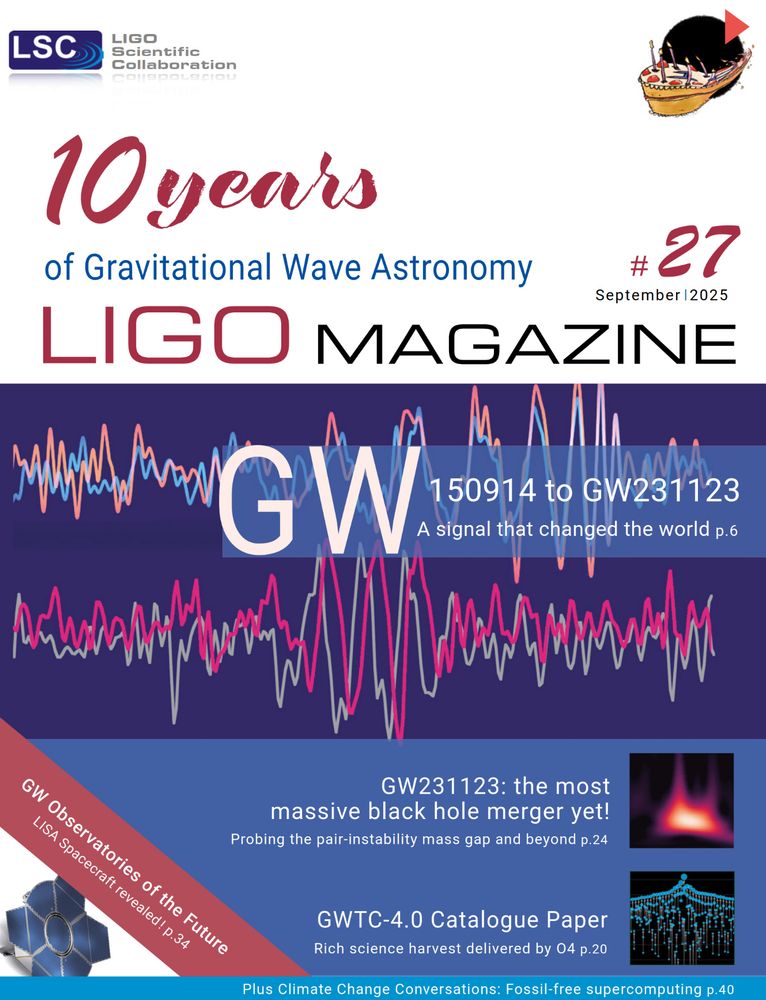
Front cover of LIGO Magazine issue 27. The headline article text reads:
"10 years of Gravitational Wave Astronomy". Two gravitational wave signals are shown in the main image - they are shown as timeseries data which look wiggles. In the top corner, an illustration of a birthday cake is shown - the cake is being distorted as it is sucked into a black hole!
Cover: Main image: GW150914 and GW231123 image by LIGO-Virgo-KAGRA/Sascha Rieger. Top inset: GW231123 plot from LIGO-Virgo-KAGRA. Bottom inset: Masses in the stellar graveyard plot by LIGO-Virgo-KAGRA/Aaron Geller/Northwestern. Bottom-left (diagonal): LISA image from OHB. Top-right corner: GW150914 birthday cake artwork by Storm Colloms.
Thank you to all who contributed to this extra long edition, especially our wonderful editorial team for all your hard work and enthusiasm!
Read this and all editions at: ligo.org/magazine/
#GW10Years
15.09.2025 15:56 — 👍 0 🔁 0 💬 1 📌 0

A page of LIGO Magazine article "GW231123 - the most massive black hole merger yet!". The page includes the title of the article and an infographic about GW231123 in blues and yellows. The infographic displays information including the mass of the two black holes (which were 137 and 103 times the mass of our sun), the distance that the signal travelled (between 2 billion light years and 13 billion light years) and how long the signal lasted in the LIGO Livingston and LIGO Hanford detectors (0.1 seconds). Image credit: Simona J. Miller / Caltech.

The image shows a page of LIGO Magazine article "GW231123: the most massive black hole merger yet!". The page includes photos of the two authors, Debnandini Mukherjee & Tanmaya Mishra. Both of them are smiling.
#GW231123 - the most massive black hole merger yet! We also caught up with Debnandini Mukherjee and Tanmaya Mishra on what makes this observation interesting plus their experience of working on the discovery paper.
#GW10Years #GWTC4
15.09.2025 14:45 — 👍 0 🔁 0 💬 1 📌 0
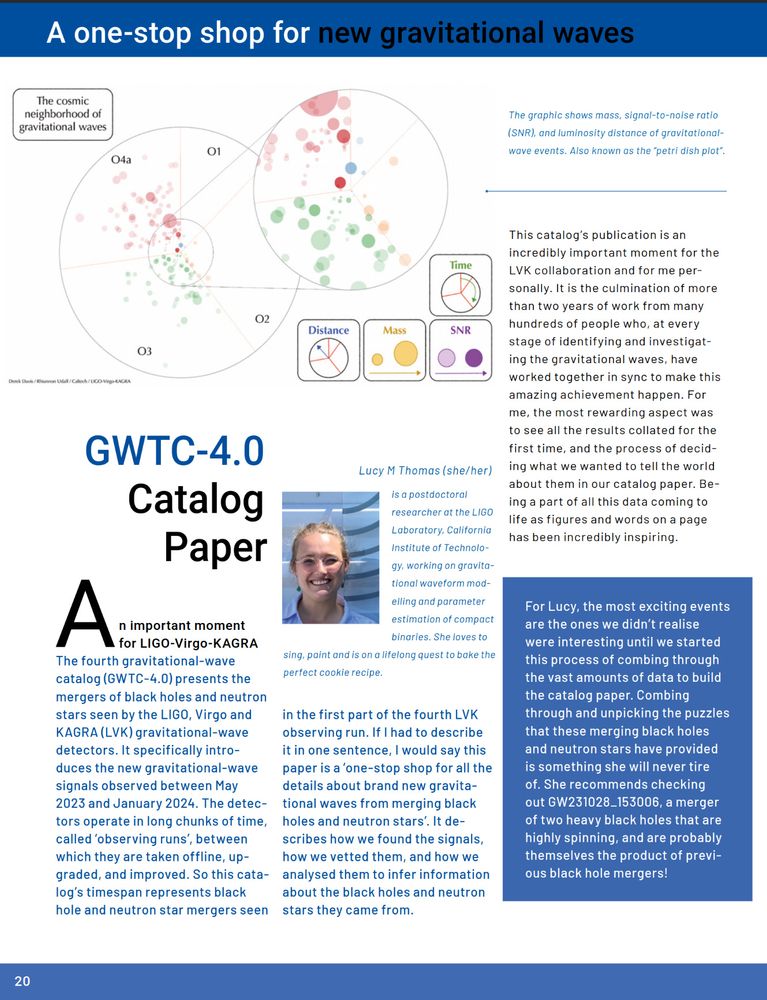
A page of LIGO Magazine article "GWTC-4.0 Catalog Paper". The page includes an image showing the gravitational wave observations so far which are indicated by circles at different distances from a central point signifying the Earth. Image created by: Derek Davis/Rhiannon Udall/Caltech/LIGO-Virgo-KAGRA
The page also includes a photo of one of the authors, Lucy Thomas.

A page of LIGO Magazine article about GWTC-4.0. The page includes a photo of one of the authors, Daniel Williams.

A page of the LIGO Magazine article about GWTC-4.0. The image at the top of the page is called the "masses in the stellar graveyard plot". It summarises the gravitational wave observations of neutron stars and black holes so far. Each object is represented by a circle and they are ordered vertically by mass. The image is full of circles representing many observations. The horizontal arrangement is purely aesthetic and appears like the spread wings of a bird. Image credit: LIGO-Virgo-KAGRA/Aaron Geller/Northwestern.
The page also shows a photo of one of the authors, Michael Pürrer.

A page of the LIGO Magazine article about GWTC-4.0. The image at the top of the page shows an older version of the masses in the stellar graveyard plot from 2017. This older version has far fewer observations compared to the current version (described in another image within this post). Image credit: LIGO-Virgo/Frank Elaysky/Northwestern University.
As well as looking back at the last decade, we take a peak at some recent results with behind the scenes stories about the latest #GravitationalWave catalog with Lucy Thomas, @daniel-williams.co.uk and @michaelpuerrer.bsky.social
#GW10Years
#GWTC4
15.09.2025 14:25 — 👍 7 🔁 4 💬 1 📌 0

Exactly 10 years ago, the signal of a gravitational wave from the merger of two black holes arrived on Earth. It was not a special signal, but one like many that had always reached our planet. On that day, however, for the first time humankind was ready to listen to it. (1/7)
14.09.2025 09:58 — 👍 28 🔁 10 💬 2 📌 0

Front cover of issue 27 of the LIGO Magazine
10 years of graviational wave astronomy
GW150914 to GW231123: a signal that changed to world (p 6)
GW231123: the most massive black hole merger yet! (p 24)
GWTC-4.0 cataglgue paper (p 20)
GW observatories of the future (p 34)
Climate change conversations: Fossil-free supercomputing (p 40)
The latest issue of @ligomagazine.bsky.social is out now and free to read
🎉 Celebrate 10 years of gravitational-wave astronomy with us 🎉
ligo.org/wp-content/u...
🔭🧪⚛️ #GW10Years
13.09.2025 18:55 — 👍 33 🔁 14 💬 1 📌 2

The title of the article "10 years of Gravitational Wave Astronomy". The text is written on a purple background. Behind the text are two gravitational-wave signals, GW150914 and GW231123. The signals are displayed as timeseries data - which is like a wiggle increasing in amplitude from left to right, before reducing.
Image credit: y LIGO-Virgo-KAGRA/Sascha Rieger.
In this edition, collaboration members past and present share their reflections and memories of the first detection of #GravitationalWaves. Stories range from the very first investigations of #GW150914 to sharing the discovery with the world and the amazing decade of discovery since! 🔭
#GW10Years
15.09.2025 10:57 — 👍 0 🔁 0 💬 1 📌 0
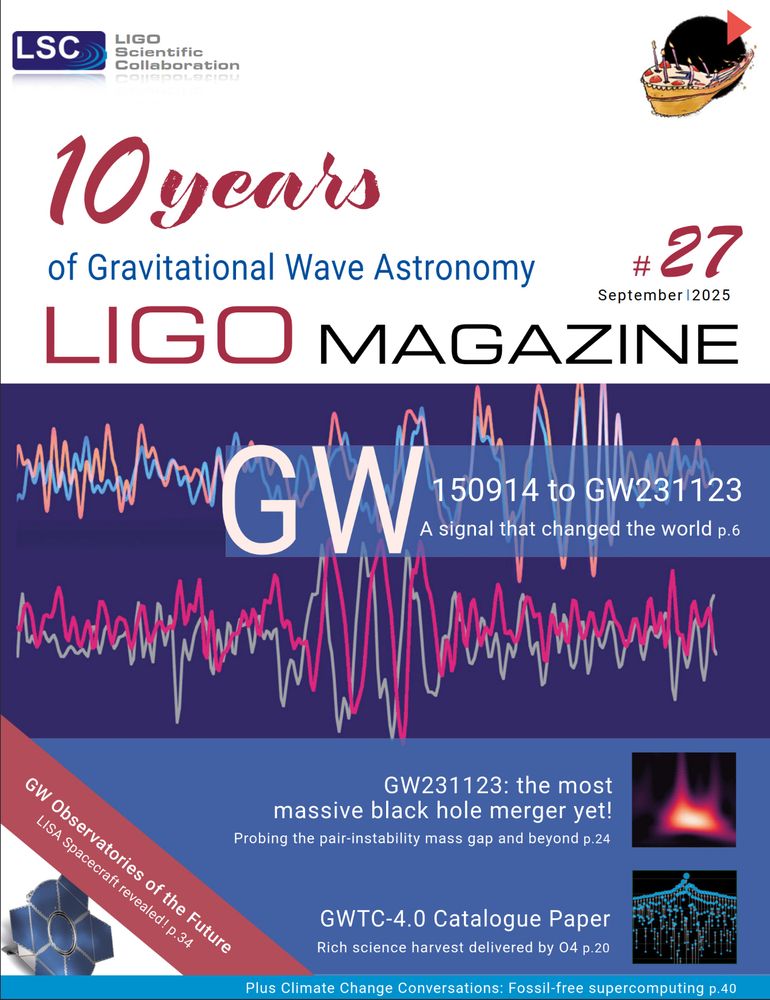
Front cover of LIGO Magazine issue 27. The headline article text reads:
"10 years of Gravitational Wave Astronomy". Two gravitational wave signals are shown in the main image - they are shown as timeseries data which look wiggles. In the top corner, an illustration of a birthday cake is shown - the cake is being distorted as it is sucked into a black hole!
Cover: Main image: GW150914 and GW231123 image by LIGO-Virgo-KAGRA/Sascha Rieger. Top inset: GW231123 plot from LIGO-Virgo-KAGRA. Bottom inset: Masses in the stellar graveyard plot by LIGO-Virgo-KAGRA/Aaron Geller/Northwestern. Bottom-left (diagonal): LISA image from OHB.
Top-right corner: GW150914 birthday cake artwork by Storm Colloms.
🎉 New LIGO Magazine out now!! 🎉
Celebrating 10 years of gravitational wave astronomy with a bumper edition!
Read it free online at (pdf):
👉 ligo.org/wp-content/u...
#GW10Years #LIGOMagazine @ligo.org @egovirgo.bsky.social
15.09.2025 10:40 — 👍 7 🔁 7 💬 1 📌 0


Today we celebrate the eight-year anniversary of a discovery that changed astronomy forever: on this day eight years ago @ligo.org and Virgo detected their first ever neutron star merger, GW170817 💥
17.08.2025 11:58 — 👍 27 🔁 8 💬 1 📌 1
New results out today from LIGO (@ligo.org) - Virgo (@egovirgo.bsky.social) - KAGRA !
The latest catalogue features more than double the number of probable signals compared to the previous one!
#GWTC4 paper: arxiv.org/abs/2508.18082
26.08.2025 13:28 — 👍 1 🔁 0 💬 0 📌 0
Check out this interview with Debnandini Mukherjee about #GW231123 !
04.08.2025 09:01 — 👍 0 🔁 0 💬 0 📌 0

A small metal component of a LIGO observatory. It is a metal device with some electronic components.
And, a LIGO (@ligo.org) BOSEM can be spotted!
BOSEMs are the Birmingham Optical Sensor and ElectroMagnetic actuator. They are components used to stabilise the LIGO mirrors, made in Birmingham!
16.07.2025 19:56 — 👍 4 🔁 0 💬 0 📌 0
Today at Carole Mundell's (@cmundell.bsky.social ) a few familiar objects can be spotted!
This mosaic shows a #GravitationalWave signal in time and frequency @uofgravity.bsky.social
Check out the story behind the first mosaic here: (page 17) ligo.org/wp-content/u...
16.07.2025 19:51 — 👍 5 🔁 1 💬 1 📌 0

A speaking giving a talk on a stage with slides projected behind them.
This year it is 10 years since the discovery of #GravitationalWaves in 2015!
www.ligo.caltech.edu/video/ligo20...
@ligo.org @egovirgo.bsky.social
#GW150914
#GR24Amaldi16
16.07.2025 19:31 — 👍 13 🔁 7 💬 1 📌 0
LIGO Magazine – LSC – LIGO Scientific Collaboration
In #LIGOMagazine, we are very happy to have a regular early career researcher column written and coordinated by our amazing GWECS team!
Check out the "LAAC Corner" series in our back catalogue of articles at ligo.org/magazine/
15.07.2025 11:02 — 👍 0 🔁 0 💬 0 📌 0

A presentation at a scientific conference. The speaker is stood on a stage. The slides are shown behind them.
GWECS includes several support structures including our own @ligo.org LAAC and @egovirgo.bsky.social VECS teams.
Mikhail Korobko (@mkorobko.bsky.social) presents GWECS support tools including the mentoring program, the recognition program, and the beginner's guide to our collaboration.
15.07.2025 10:57 — 👍 3 🔁 0 💬 0 📌 1

A presentation at a scientific conference.
Want to find out more about GWECS???
Elisa Maggio presents GWECS activities including workshops, job fairs, sharing fellowship/grant opportunities and news.
Check out GWECS and subscribe to the mailing list at gwecs.org
#GR24Amaldi16
15.07.2025 10:49 — 👍 0 🔁 1 💬 0 📌 0

A slide being presented at a conference. The slide images show participants at the GWECS workshop.
One way to support early career scientists is holding workshops. GWECS hosted a workshop last week with support of the #GR24Amaldi16 local organising committee.
Golam Shaifullah, Christopher Berry (cplberry.bsky.social), Rachel Gray share their experience of hosting this very successful workshop!
15.07.2025 10:45 — 👍 0 🔁 0 💬 0 📌 0
Astronomer, occasional artist, sometimes takes pictures
(she/her)
#50YearsOfESA: we're the European Space Agency, keeping you posted on European space activities.
Please see our Privacy Notice: https://esa.int/connectwithus
Gravitational wave astrophysicist at the University of Rhode Island and member of the LIGO Scientific Collaboration. Also an amateur artist sometimes?
I'm an astronomer at @uofgravity.bsky.social working to understand ripples in the Universe (gravitational waves) made when dead stars (black holes and neutron stars) crash into each other.
(he/him | e/esan)
Tha mi nam neach-ionnsachaidh.
🏴🏳️🌈🏉⛰️🚴♂️🏃♂️🚣♂️
Gravitational wave astronomy, AI/ML, data analysis & source modeling for mergers or black holes and neutron stars
Physics & Center for Computational Research @ University of Rhode Island
Professor, Physics and Astronomy (LSU), LIGO Livingston observatory head (Caltech). Content here is my personal take, not representing my organizations.
On a break. Message via website (link below)
Writer | Science Advisor (Star Trek franchise) | Producer | PhD, Astrophysics | she/her
just an ancient tattooed 🏴 N7 Starfleet rebel pagan soul trapped in modern times
https://linktr.ee/drerinmac
🕵️ Investigator of ripples in space-time (astrophysicist)
✨ Postdoc fellow at Northwestern Uni + Adler Planetarium 🇺🇸
linktr.ee/astronerdika | 🇦🇺🇱🇰(she/her)
Assistant Professor at UNLV+NevadaCfA looking for gravitational waves and the best music. Previously at LIGO, MITKavli, CITA_ICAT and UoBIGWaves.
NASA Einstein Fellow at Northwestern studying gravitational waves with LIGO | previously PhD at MIT | violinist and cat lover
Virgo is a Gravitational Wave detector, hosted by the European Gravitational Observatory (EGO), near Pisa, Italy.
The University of Glasgow Communications team. News and expert comment. Contact media@glasgow.ac.uk
Official account of the LIGO Scientific Collaboration. We detect gravitational waves!
Email: questions@ligo.org
Keeping you posted on space science activities from the European Space Agency.
Web: http://www.esa.int/science
Privacy Notice: esa.int/connectwithus
#astronomy #space #science
PhD at the University of Glasgow, illustrator, astrobiter
they/them 🏳️⚧️
one time i dressed up as a higgs boson to a party and really thats all you need to know
scolloms.github.io
First gravitational wave observatory in space. 3 satellites flying in triangle formation connected by 2.5 million km laser beams. An ESA mission with international participation including from NASA. Launch in the 2030s.
Gravitational-wave astrophysicist. University of Glasgow Senior Lecturer. Science, education, LEGO & cake. May contain traces of nuts
🐘 https://mastodon.online/@cplberry
🐦 https://twitter.com/cplberry
📚 https://cplberry.com
Looking for gravitational waves, modelling light.
Photos are taken by me unless stated otherwise (provided under a CC BY-NC-SA 4.0 license).
official Bluesky account (check username👆)
Bugs, feature requests, feedback: support@bsky.app






























